The Images of the Life Cycle (Vita) of Saint Nicholas in the Shrine of Saint Nicholas at Ground Zero
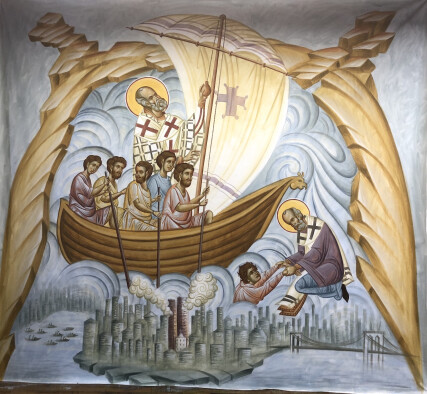
In past issues of the Newsletter, the significance of including images from the Life Cycle (Vita) within the iconographic program of the Shrine of Saint Nicholas was highlighted. In addition to being the Patron Saint of the Shrine, Saint Nicholas is recognized as one of our most popular saints, venerated for his great intercessory powers. He is especially remembered as a holy hierarch who rescues innocent individuals from dangers and acts as a great intercessor at tribunals for those wrongly condemned. Learn more about this icon.
The Images of the Souls of the Righteous in the Hand of God in the Shrine of Saint Nicholas at Ground Zero

The narthex of the Shrine of Saint Nicholas at Ground Zero opens to the left and to the right into two candle-room areas, where the faithful and visitors may light candles before entering the nave, as is customary in Orthodox churches. In each of these lateral spaces, at the center of each ceiling is a large, circular, recessed area in which is found the image known as "The Souls of the Righteous in the Hand of God." In each of these identical images, the Hand of God is shown holding the Souls of the Righteous who appear as young, swaddled infants. Learn more about this icon.
The Images of the Deesis in the Shrine of Saint Nicholas at Ground Zero
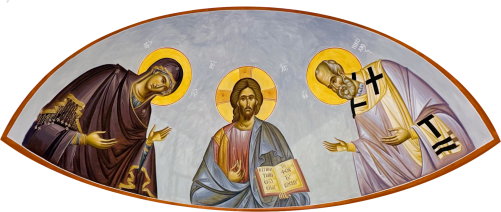
In the conch of the curved surface of the semihemisphere or quarter-sphere extending into the narthex from the nave of the Shrine of Saint Nicholas at Ground Zero, there is the image of the Deesis: in this example composed of the central half-length image of Christ, flanked by half-length images of the Mother of God and Saint Nicholas, both of whom extend their hands towards Christ in a prayerful, reverential gesture. The technical term Deesis (transliterated from the Greek word -meaning entreaty or intercession or intercessory prayer) has most often been applied to the sacred image of Christ flanked by His Mother (to His right) and Saint John the Baptist, the Forerunner or Prodromos (to His left), the most well-known example beingthat of the monumental 13th century mosaic in the south gallery of Hagia Sophia in Constantinople.Learn more about this icon.
The Communion of the Apostles
![]()
Among the three sacred images found on the eastern wall of the sanctuary of the Shrine of Saint Nicholas at Ground Zero is that of the Communion of the Apostles, identified here by its accompanying Greek inscription, ἡ Μετάληψις (the Partaking of the Elements of the Eucharist). Although images of the Communion of the Apostles can be found as early as the 6th century in manuscripts and on liturgical patens, scholars have shown that the scene does not appear in the central apse of Orthodox church sanctuaries until the 11th century, reflecting a period that witnessed a greater interest in depicting liturgical ceremonies. From this point onward, this image become a standard feature in sanctuary iconographic programs. The scene of the Communion of the Apostles has its roots in the Gospel accounts of the Last Supper (Matthew 26:17-29; Mark 14:12-26; Luke 22: 7-23; and John 13: 1-30). It emphasizes the divine institution of the sacrament of the Eucharist by Christ but presented within a liturgical context. Learn more about this icon.
The Titular Icon of Saint Nicholas in the Shrine at Ground Zero
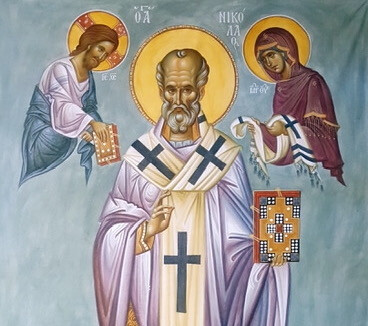
Upon entering the narthex of the Shrine of Saint Nicholas at Ground Zero, one will find a large, full-length icon of Saint Nicholas to the right of the doors leading into the nave. The Holy Hierarch’s large image appropriately appears in the narthex as the patronal Saint of the Shrine. His holy presence is immediately encountered by all faithful and visitors who enter this sacred space. Learn more about this icon.
The Installation of the Iconographic Program
![]()
Now that the Consecration of the Saint Nicholas National Shrine is complete, the Shrine will close to the public for a short while, while the installation of the Iconographic Program takes place. The Church must be closed to the public during this time, as there will be an intricate scaffolding erected, to allow Father Loukas and his assistants to place the iconography in all of the appropriate spaces. Father Loukas had already installed some of the icons for the Consecration, but the full complement of images will fill the dome and walls with a coherent iconographic program. A Byzantine/Orthodox church is understood as complete when its interior surfaces are properly embellished. Architecture and iconography work together to create a unified entity. Learn more about this icon.
The Pentecost

Among the images of the Christological cycle that will appear in the Shrine of Saint Nicholas is that of the Pentecost (ἡ Πεντηκοστή – meaning “fifty”) depicting the event of the Descent of the Holy Spirit in the form of Fiery Tongues upon the Apostles fifty days after Christ’s Resurrection. The Biblical event is recorded in Acts 2 which relates how upon receiving the Holy Spirit, the Apostles began to speak in various languages, proclaiming the salvific message of Christ’s Resurrection to the world, drawing many into the Faith through Baptism and the life of the Church. The Pentecost event had been prophesied already in the Old Testament Book of Joel 2:28-32, “And it shall come to pass afterward, that I will pour out my Spirit upon all flesh…..” This text from the Book of Joel is read at the Great Vespers for the Feast of Pentecost. Learn more about this icon.
The Ascension

Among the images of the Christological cycle that will appear in the Shrine of Saint Nicholas is that of the Ascension (ἡ Ἀνάληψις), depicting Christ’s ascent into Heaven on the 40th day after His Resurrection. The biblical event is recorded in the Gospels of Mark (16:19) and Luke (24:50-53) and in the Book of Acts (1:9-12). In these Scriptures, one reads how, after further instructing the Disciples and telling them that the Father will send them the Holy Spirit, the Lord led them out as far as Bethany, to the Mount of Olives, and while He was blessing them He ascended into Heaven. Learn more about this icon.
The Image of the Anastasis in the Shrine of Saint Nicholas
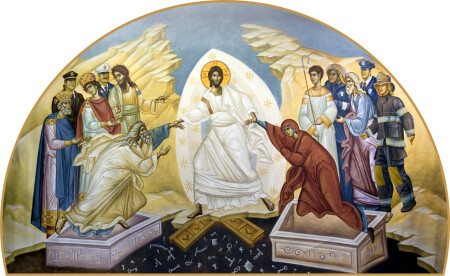
The image of the Anastasis (the Resurrection) is one of the essential images within the Byzantine/Orthodox Christological cycle found in all media. It is simultaneously both a simple and richly complex image, revealing the dramatic miracle of Christ’s resurrection from the dead and profound theological doctrines. The term is taken from the active and middle forms of the Greek verb: ἀνίστημι-anistemi (to rise up; to raise up) and ἀνίσταμαι-anistamai (standing or rising up). Both meanings apply to the events depicted in the icon: Christ rises from the dead by His own agency; Christ raises the dead to enter eternal life. Learn more about this icon.
The Image of the Mother of God as Protectress of New York City
in the Apse of the Shrine of Saint Nicholas
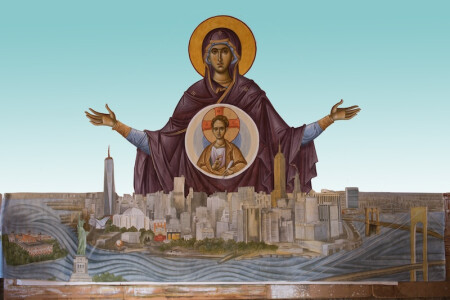
In Byzantine/Orthodox churches of a centralized, domed plan, some type of image of the Mother of God is usually placed in the conch of the apse of the sanctuary wall. This is also the case for that of the Shrine of Saint Nicholas at Ground Zero. As early as the eighth century, the sainted patriarch Germanos I, when writing in his Commentary on the Divine Liturgy (Historia Ekklesiastika), understood the conch of the apse to symbolize the cave of Bethlehem where Christ was born and that below it is the altar table on which Christ’s Body, the Heavenly Bread, is present. As the vehicle of the Incarnation, in which Christ receives His Human Flesh from His Mother, it is most appropriate that her image is accorded a prominent place in the sanctuary. Learn more about this icon.
The Images of the Four Evangelists in the Shrine of Saint Nicholas
![]()
As noted in several previous issues of this Newsletter, after the period of Iconoclasm (ending in 843), Byzantine ecclesiastical architecture emerged most characteristically as a centralized plan surmounted by a prominent dome. This form of architectural plan readily serves to reflect the hierarchical system of the Orthodox Faith and its visual expression, whereby the dome, the highest point within the church structure, became associated with Heaven and thereby was reserved for the depiction of the holiest figure, Christ Himself. Learn more about this icon.
The Image of the Baptism of Christ: The Theophany
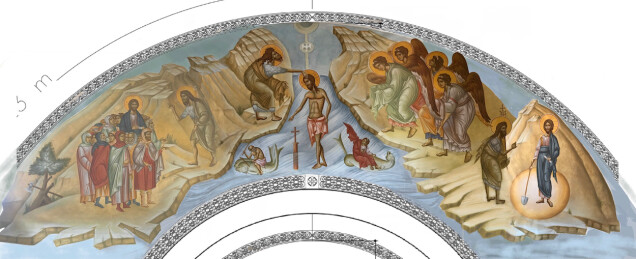
As noted in previous Newsletters, Byzantine/Orthodox churches were provided with a number of images referred to as the Christological cycle, that is a cycle of images depicting scenes from the life of Christ and/or the Theotokos. These scenes often correspond to the major feasts of the liturgical year, thus linking the sacred images with liturgical celebrations of special feast-days and also to the Eucharist’s commemorative aspect of the entire saving events of the life of Christ. Learn more about this icon.
Nativity Images in the Shrine of Saint Nicholas

As outlined in previous Newsletters, Byzantine/Orthodox churches customarily were provided with a number of images referred to as the Christological cycle, that is a cycle of images depicting scenes from the life of Christ and/or the Theotokos. Often these scenes were the same events corresponding to the 12 major feasts of the liturgical year, thus linking the sacred images with liturgical celebrations of special feast-days and also to the Eucharist’s commemorative aspect of the entire saving events of the life of Christ. In addition, Byzantine/Orthodox churches that were dedicated to a particular saint often included depictions of scenes from the life of that saint, referred to as the saint’s Vita or Life cycle or Hagiographic cycle. Learn more about this icon.
The Image of the Patron of Orthodoxy in
The Shrine of Saint Nicholas
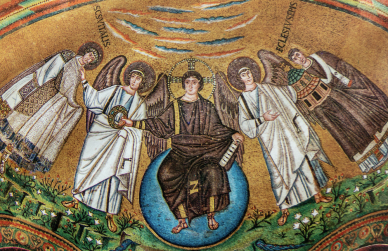
On 2 November, the Thirtieth Anniversary of His Enthonement on the See of the First Called Disciple Saint Andrew in Constantinople, which is the Feast of Saint Elpidophoros the Martyr, His All-Holiness Ecumenical Patriarch Bartholomew presided over the Thyranoixia service for the Shrine of Saint Nicholas at Ground Zero and the raising of the permanent Cross installed on the apex of the dome. This ceremony of initiation, led by the Spiritual Leader of world-wide Orthodoxy, marked a significant and sacred moment of entry into the Shrine in preparation for its future, full liturgical use and place of pilgrimage. Learn more about this icon.
The Inscriptions on the West Facade
![]()
It is perhaps no accident of history that that the Athena Victory (Nike) Temple is the first structure that confronts the visitor to the Acropolis, and that the meaning of “Nicholas” is “the Victory of the People” (e nike tou laou). Just as the Parthenon reminded the ancient Athenians of the price for their freedom, so the Saint Nicholas Shrine at Ground Zero reminds the whole American People that our most treasured freedom is that of religious belief according to our conscience, and that mutual respect for all religions is the only way to live in a world without war and violence. The words of our Lord Jesus Christ, and the words of Pericles of Athens, which will be forever etched on the front of the Church, will ensure that we never forget. Learn more about this icon.
Bishop Joachim of Amissos
A Portrait of the Renown Byzantine Art Expert
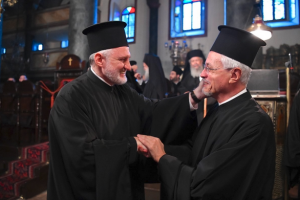
Father Loukas, the iconographer whose prayerful and Spirit-filled work will adorn the Saint Nicholas National Shrine is a well known figure, particularly to Father Alexander Karloutsos, who urged that this remarkable monastic be commissioned to paint the icons for Saint Nicholas prior to the election of Archbishop Elpidophoros. Nevertheless, the program that Father Loukas was asked to execute was at best, underdeveloped and in some cases, incomplete. His Eminence Archbishop Elpidophoros, together with the Friends of St. Nicholas (FoSN), asked the newly-elected Bishop of Amissos, His Grace Joachim (Cotsonis), an internationally recognized scholar of the traditions of Byzantine Art, to review the interior spaces, and submit his recommendations. Learn more about this icon.
The Images of the Prophets in the Dome
of the Shrine of Saint Nicholas

Depictions of Prophets were included in church iconographic programs at least as early as the 6th century, as seen in the various mosaic decorations of the Byzantine churches of Ravenna. After the period of Iconoclasm (ending in 843), when Byzantine ecclesiastical architecture emerged most characteristically as a centralized plan surmounted by a prominent dome at its core, it became customary to place images of the Prophets in the dome, below the central medallion bust-length-figure of Christ, usually referred to as the Pantokrator. The dome, the highest point within the church structure, became associated with heaven and thereby was reserved for the depiction of the Lord and His ministering servants. Depending on the architectural structure of a church dome, the images of the Prophets, depicted standing, are placed between the ribs that radiate centrally from the center of the dome and central image of the Christ Pantokrator, or they are placed on the walls of the upright drum of the dome. Learn more about this icon.
Prothesis & Diakonikon Images
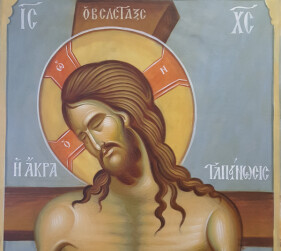
The sanctuary of a Byzantine/Orthodox church is adorned with many and various sacred images: those found on the icon-screen (iconostasis, templon), those that appear on the east wall (the apse and conch of the apse), on the side walls of the sanctuary, and on the arch over the sanctuary. However, in addition to these spaces where the icons are more visible to the faithful, there are two other significant liturgical spaces within the sanctuary proper, auxiliary chambers or niches, which flank the apse and customarily receive sacred images: the prothesis on the left or north side, and the diakonikon on the right or south side. Collectively, these auxiliary spaces were referred to as pastophoria and became standard from the 9th century onwards as part of the typical, centrally planned, domed church. Learn more about this icon.
The Images of the Holy Hierarchs in the Sanctuary of the
Saint Nicholas National Shrine at Ground Zero
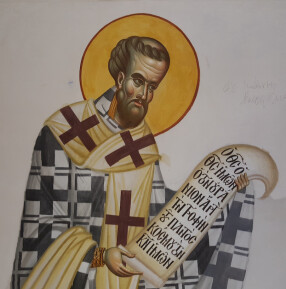
One of the main iconographic elements usually found in the sanctuaries of Byzantine/Orthodox churches is the presence of images of saintly Hierarchs at the lowest level of the east wall, closest to the Altar Table itself, and to the actual space occupied by the celebrating clergy. For centuries, the sanctuary space has been regarded as the most sacred part of a church building since it is the place of the Altar on which the Eucharistic gifts are transformed into the true Body and Blood of Christ. Learn more about this icon.
Father Loukas of Xenophontos – Iconographer Extraordinaire

It is very rare to learn the details of a monk’s life. They retreat from the world, not for any fame or personal glory, but to enter into a deeper relationship with God on the world’s behalf. Father Loukas, the iconographer whose prayerful and Spirit-filled work will adorn the Saint Nicholas National Shrine, is a true monk. He seeks not personal glory, fame, or recognition. He paints because it is his Spirit-filled vocation. And we are so very blessed that he is the one whose work will fill Saint Nicholas. Learn more about Father Loukas.
The Image of Christ in the Dome
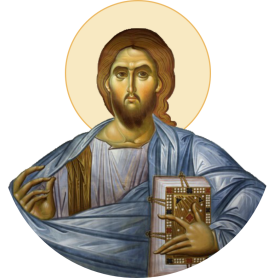
After the period of Iconoclasm (ending in 843), Byzantine ecclesiastical architecture emerged most characteristically as a centralized plan surmounted by a prominent dome at its core. It continues as the most common scheme for an Orthodox church today. This form of architectural plan readily serves to reflect the hierarchical system of the Orthodox Faith and its visual expression, whereby the dome, the highest point within the church structure, became associated with heaven and thereby was reserved for the depiction of the holiest figure, Christ Himself. This has become the definitive image of the interior space of Orthodox churches. Learn more about this icon.